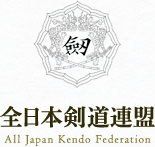- 全日本剣道連盟トップ
- 剣道を知る
- 剣道に関する全剣連の見解
剣道に関する全剣連の見解
All Japan Kendo Federation's Perspective of KENDO
最近、インターネット上などで「剣道の起源は日本ではなくて韓国である」という記述がしばしば見かけられますが、全日本剣道連盟はこれまで、これに敢えて反論はしてきませんでした。というのは、剣道は日本の武士の生活の中から生まれた日本独特の文化であるという考えでいたからです。しかし、最近、上のような記述がますます頻繁に見られるようになってきたことから、改めてわれわれの見解や方針について広く知って頂く必要があると考えました。
Dear Kendo Friends,
Recently, many of you may have seen postings on various Internet websites suggesting the “origin of Kendo is in Korea and not Japan.” The All Japan Kendo Federation (heretofore, AJKF) has not bothered to reply to these assertions, because we think Kendo is a culture characteristic of Japan which developed from the life and spirit of the Samurai ( or Bushi, synonym of Samurai ) of Japan. However, since the above-mentioned assertions seem to be increasing, we feel that it is necessary to make a formal statement of our opinion and position so that it may be known to you all.
「剣道」とは、日本の武士が剣(日本刀)を使った戦いを通じ、剣の理法を自得するために歩む道を指し、剣道を学ぶということは、この剣の理法を学ぶことを意味します。敢えて言えば、剣の理法の奥にある武士の精神を学ぶことが重要で、剣の操法を厳しい稽古を通じて学ぶことは、その為の一つの手段と見られています。これが剣道の目的が「人間形成の道」と言われている理由です。
Kendo denotes the “nature (Riho) of the Ken” which was self-taught and acquired by the Japanese Samurai (warrior) through their experiences in many battles using their sword. Therefore, the learning of Kendo means learning the nature of the Ken. To state further, it is important to study the spirit of the Samurai which is within the nature of the Ken. And a means of learning this spirit is learning how to use the sword through harsh training. This is the reason why the objective of Kendo is usually referred to “the way of developing the person.”
鉄の発見とともに鉄製の剣が作られるようになり、それと共に鉄製の剣を使っての戦いが始まりました。剣の形態やその操法も、幾多の戦いの中で時の流れと共に、変化していきました。そもそも、各地域にある文化とは、人類の移動、交流とともにお互いに影響しあい、発展をとげていったものです。そして次第に人種、国境を超えた世界人類の文化となっていくものです。
そのような過程を考えると、ある時代の中ででき上がった一つの文化を取り上げて、その起源を論じ、その発祥の地を特定の国だけにはめこむことは、所詮無理なことであり、余り意味のあることではないと考えています。これは剣道についても同様です。
剣を扱う技術は世界の各地で生まれ、確立されてきました。しかし、その中で、われわれが行っている剣道とは、「剣道の歴史」にも記されているような、日本で育った歴史的背景をもった剣道を指しています。
Battles with the use of swords began with the discovery of iron and the development of the iron sword. The shape of the iron swords and their handling methods have changed with the passage of time.
To begin with, cultures of all regions influence each other from the movement and exchange of goods and people, and eventually develop over a period of time. And, gradually it becomes a culture that is known throughout the world beyond races and the borders of countries.
From this point of view, it is quite difficult or even ridiculous to assert that one particular culture developed from one particular era and originated from one particular country. In the same way, Kendo is no exception. Various types of sword skills were founded and developed in all parts of the world. However, the Kendo that we know now, as is explained in “The History of Kendo”, has a long historical background of development in Japan
日本においては、平安時代中期に反りと鎬を持つ独自の刀(日本刀)が作られ、以後、戦いにおける主要な武器として使われるとともに、次第に武士の精神的象徴としての位置づけを持つようになりました。このことから、刀は武士の心と言われるようになり、さらに、あるべき心を示すような強さと美を表す芸術品として開花しました。
一方、戦国時代から江戸時代初期にかけて、剣の操法としての剣術に多くの流派が生まれ、江戸中期には、剣道具が開発されました。この結果、竹刀によって行う剣術の稽古(竹刀打ち込み稽古)が定着し、道場における剣術の試合も幕末にかけて急速に広まり、明治維新を経て大正初期には、撃剣・剣術という語を「剣道」と改め、これが日本の武士の精神に基づく「武道」であると説きました。
剣道は、このように日本の歴史の中で生まれ育ってきたのです。つまり「剣道」とは他のいずれの地で生まれたものでもなく、このような経過とともに発展してきた剣道のことなのです。
In the middle of the 10th century (Heian Era ) of Japan, swords that had original features of Sori (a slightly arched blade) and Shinogi ( raised ridges of the blade), were made and became the main weapon used in the battlefields. These swords symbolized the Samurai’s spirit. From this, the Japanese sword is said to embody the “mind” of the Samurai, and it has developed and flourished as a work of art that represents the strength and beauty of the true “Mind.”
During the 15th and 16th centuries (during the era of warring states and the early Tokugawa Era), many schools of Kenjutsu were established, and in the 18th century (in the middle of the Tokugawa Era) Kendo-gu was developed. As a result, a new Kenjutsu training method using Shinai (bamboo swords) was established, and a new type of Kenjutsu competition gained popularity in the local Dojos and spread across the country in the middle of the 19th century (around the end of the Tokugawa Era). Early in the 20th century (after the Meiji Restoration and in the beginning of the Taisho Era), this type of training which was referred to as Gekiken or Kenjutsu was renamed Kendo. And, Kendo was said to represent Budo which was based on the spirit of the Japanese Samurai. In this manner, Kendo that we know now is the Kendo that developed through this long historical process.
全剣連は、このような日本独特の文化・武道である剣道をさらに普及させていきたいと考えていますが、一方、剣道の普及とは、単に剣道人口を増加させたり、試合を数多く開催することではありません。正しい普及とは、日常の稽古や試合という競技の剣道を通じて、武士の精神を多くの人々に伝えることです。単なる競技として広めることではないのです。
このような観点から、剣道を学ぶ世界中の皆さんにお伝えしたいことが一つあります。それは、剣道の厳しい稽古を通じて、剣の技を学ぶだけではなく、武士の生活態度やそれを裏付ける武士の精神(心構え)も学んで頂きたいということです。
つまり、武道としての剣道を理解し、その修練をして頂きたいということです。竹刀は武士の刀です。稽古着、袴は武士の正装であり、単なる運動着ではありません。この精神を学ばずに剣道をすることは、単なる肉体的運動をしていることになってしまいます。剣道の奥深さ、文化性を理解して頂きたいと思います。
われわれは、皆様のご理解を得ながら、このような正しい剣道の普及に努めていきたいと考えています。
今後とも一層のご支援、ご協力をお願いいたします。
財団法人 全日本剣道連盟
The AJKF will engage in the promotion of Kendo or what can be considered as Budo, a culture of Japanese distinction. Promotion of Kendo neither means merely to increase the number of Kendo practitioners, nor to hold more competitions. The AJKF believes that promotion will involve the communication of the “spirit of the Samurai” through everyday training and competition. Kendo should not be promoted just as a competitive sport.
With this in mind, there is one thing that needs to be understood by those engaging in Kendo around the world. And that is, through the harsh training of Kendo, our hope is that you learn not only the technical skills of the sword, but to understand the social and ethical aspects of the Samurai as well as the spirit (mental attitude) of the Samurai. In other words, we hope that you will understand Kendo as Budo and to experience the training of it. A Shinai is a Samurai’s sword. Keiko-gi and Hakama are a Samurai’s formal attire. They should not be considered simply sports-wear. Without understanding this “spirit,” Kendo will merely be another physical exercise. We hope that you will try to understand and appreciate the profundity and cultural values of Kendo.
The AJKF hopes to promote what we believe to be authentic Kendo. We would like to ask for your full support and cooperation to our activities.
Thank you for your attention.















